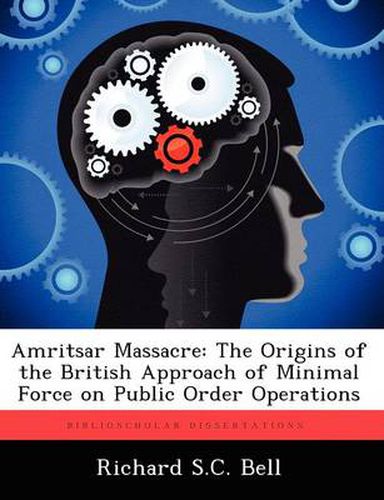Readings Newsletter
Become a Readings Member to make your shopping experience even easier.
Sign in or sign up for free!
You’re not far away from qualifying for FREE standard shipping within Australia
You’ve qualified for FREE standard shipping within Australia
The cart is loading…






This title is printed to order. This book may have been self-published. If so, we cannot guarantee the quality of the content. In the main most books will have gone through the editing process however some may not. We therefore suggest that you be aware of this before ordering this book. If in doubt check either the author or publisher’s details as we are unable to accept any returns unless they are faulty. Please contact us if you have any questions.
Since the end of the Cold War the British Army has been involved in crowd control operations outside the national boundaries of the United Kingdom. The recent deployments to Iraq and Afghanistan have caused the traditional British approach of minimal force in crowd control operations to be pressurized by a desire for a more rapid and direct solution to crowd control operations. This paper provides a study of how the British directed policy of minimal force in crowd control operations evolved from the incident at the Jallianwala Bagh in Amritsar in 1919. Here, British Indian troops under the command of General Sir Reginald Dyer opened fire on a protesting Indian crowd killing hundreds. The incident has been attributed with providing the spark that led to Indian Independence and the fall of the British Liberal Party. The main lessons learned from the Amritsar massacre in 1919, use of minimal force, good civil military relations, and a requirement for clear legal guidance governing the employment of troops, have shaped current British military crowd control doctrine. This paper demonstrates how the current British doctrine is directly linked to the events at the Jallianwalla Bagh and provides a case study proving the importance of minimal force, good civil military relations and clear legal guidance that should not be forgotten in current operations. The findings of the paper have been justified by examining the highly emotive and biased writings on the subject, drawing a logical sequence of events of the riot and then comparing the incidents after effects to the clear direction in current British Army doctrine. These findings demonstrate a direct linkage to the events in Jallianwalla Bagh in current British doctrine for the use of troops in crowd control operations.
$9.00 standard shipping within Australia
FREE standard shipping within Australia for orders over $100.00
Express & International shipping calculated at checkout
This title is printed to order. This book may have been self-published. If so, we cannot guarantee the quality of the content. In the main most books will have gone through the editing process however some may not. We therefore suggest that you be aware of this before ordering this book. If in doubt check either the author or publisher’s details as we are unable to accept any returns unless they are faulty. Please contact us if you have any questions.
Since the end of the Cold War the British Army has been involved in crowd control operations outside the national boundaries of the United Kingdom. The recent deployments to Iraq and Afghanistan have caused the traditional British approach of minimal force in crowd control operations to be pressurized by a desire for a more rapid and direct solution to crowd control operations. This paper provides a study of how the British directed policy of minimal force in crowd control operations evolved from the incident at the Jallianwala Bagh in Amritsar in 1919. Here, British Indian troops under the command of General Sir Reginald Dyer opened fire on a protesting Indian crowd killing hundreds. The incident has been attributed with providing the spark that led to Indian Independence and the fall of the British Liberal Party. The main lessons learned from the Amritsar massacre in 1919, use of minimal force, good civil military relations, and a requirement for clear legal guidance governing the employment of troops, have shaped current British military crowd control doctrine. This paper demonstrates how the current British doctrine is directly linked to the events at the Jallianwalla Bagh and provides a case study proving the importance of minimal force, good civil military relations and clear legal guidance that should not be forgotten in current operations. The findings of the paper have been justified by examining the highly emotive and biased writings on the subject, drawing a logical sequence of events of the riot and then comparing the incidents after effects to the clear direction in current British Army doctrine. These findings demonstrate a direct linkage to the events in Jallianwalla Bagh in current British doctrine for the use of troops in crowd control operations.